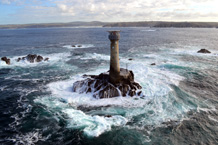Articles

Image courtesy of: Peter Ganderton.
Stormlamp project to shine light on the impact of waves on lighthouses
Engineers have launched a new research project to examine the structural impact that waves have upon six of the most exposed rock-based lighthouses in the UK and Ireland.
A team drawn from the Universities of Exeter, Plymouth and UCL will use a variety of field and laboratory tests, with computer modelling, to evaluate the level of vibration the lighthouses endure from the constant battering of the sea.
The lighthouses to be studied are Les Hanois, in the English Channel near Guernsey; Bishop Rock, Wolf Rock and Longships, in Cornwall; Fastnet, to the south of Ireland; and Dubh Artach, off the west coast of Scotland.
STORMLAMP - STructural behaviour Of Rock Mounted Lighthouses At the Mercy of imPulsive waves – is being funded by a £1,000,000 grant from the Engineering and Physical Sciences Research Council and will extend over the next three and a half years.
Project lead, Dr Alison Raby, of the School of Marine Science and Engineering at Plymouth, said: “These historic rock-mounted lighthouses are truly iconic structures, but they still play a vital role in helping vessels to navigate safely around perilous reefs, even with the advancement of GPS navigational technology. But if they are to continue to provide a valuable physical visual aid, we need to understand how their longevity might be affected by the battering they receive from the waves, especially with increased climate-related storminess.”
The STORMLAMP project builds upon a trial conducted by Plymouth, with the support of the General Lighthouse Authorities (GLAs), into the response of the Eddystone Lighthouse, off Plymouth, to different wave conditions. The study evaluated the extreme logistical constraints of lighthouse operations and the feasibility of using instrumentation to understand the response of the lighthouse to wave loads, with results strongly encouraging a comprehensive study of the load and response behaviour.
Engineers from Exeter will lead the structural monitoring, using specialist equipment to record the different vibrations caused by varying wave loading conditions. They recently conducted a ‘dry run’ on the iconic Smeaton’s Tower in Plymouth, using an electro-dynamic shaker and accelerometers to establish the principle of the work.
Professor James Brownjohn, leading the Exeter team, said: “We will generate minute horizontal movements using the shaker and, by comparing the movements with the shaker forces, we’ll be able to identify the stiffness properties of the lighthouse”.
Colleagues at UCL will create a sophisticated multi-scale numerical simulation of the lighthouses that can be used with the data gathered on site to create long-term diagnoses. The numerical structural model will also be linked with advanced physical modelling at Plymouth University's COAST Laboratory, and numerical (computational fluid dynamic) simulations.
Professor Dina D’Ayala, of UCL Civil, Environmental and Geomatic Engineering, said: “The six lighthouses which will be studied during the STORMLAMP project form part of an historically critical network around the British Isles that must be maintained. This project will play a key role in developing our understanding of how we can increase their lifespan against the increased storminess caused by climate change. The opportunity to directly study the impact of waves on these coastal structures will also allow this knowledge to be applied to protecting a range of other coastal defences.”
Depending on the findings, the investigation will then focus on extended full-scale evaluation of one lighthouse for the following two winters. Ultimately, the findings will be used to inform the comprehensive structural health monitoring of other lighthouses both in the British Isles and further afield through the International Association of Lighthouse Authorities.
Date: 2 June 2016
